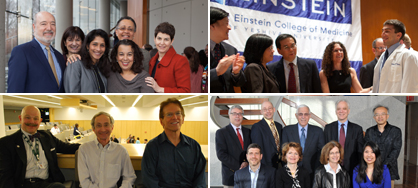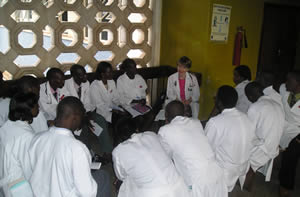

Global Disease Initative
Meredith Hawkins: Leading Einstein's Global Diabetes Initiative in Tackling a Dire Epidemic
Growing up in Toronto, Canada, an impressionable and curious 12-year-old girl named Meredith Hawkins became fascinated by diabetes. Driving her interest was the story of the discovery of insulin in 1921 by two famous Canadians, Frederick Banting and Charles Best — providing a life-saving remedy for a disease that, at that time, was universally fatal in childhood. Her fascination with diabetes led her to attend medical school at the University of Toronto — the very institution where Banting and Best made their groundbreaking discovery. Today, as a physician-scientist at Einstein, Dr. Hawkins still considers diabetes to be the most interesting disease that she has ever encountered.

Dr. Meredith Hawkins meets with medical staff at
Makerere University in Kampala, Uganda, where she
and other Einstein faculty members are partnering
with medical staff to develop a diabetes training
program.The global reach of diabetes is staggering. According to the World Health Organization, it currently afflicts 170 million people worldwide — with a predicted increase to 370 million by the year 2030. To put this in perspective, Dr Hawkins notes, "If you compare these statistics with those for HIV/AIDS, which is estimated to affect 33 million globally, you realize that diabetes is an epidemic of phenomenal proportions."
As director of the Global Diabetes Initiative (GDI) at Einstein, Dr. Hawkins leads a team of dedicated researchers and physicians who are battling diabetes around the world. "Our mission is to harness Einstein's prowess in medical research and education to combat the burgeoning global diabetes epidemic," she says.
Initially, Dr. Hawkins' focus on diabetes was more local in scope. Working in the Bronx offered ample opportunity to provide treatment and conduct research amid a diverse patient population, where census reports indicate that nearly one-third of residents come from another country and more than half speak a language other than English at home. Then, in 1996, friends invited her to join them on a short-term medical trip to rural Romania.
"At the time, I thought of diabetes as a First World problem," says Dr. Hawkins. "I thought I would be of no use whatsoever to my friends, because I knew precious little about parasites and other infectious diseases that I thought we would be steadily coming across."
She quickly learned otherwise. "Once there, I was able to observe firsthand that it was actually diabetes, rather than parasites, that was the major health issue for the people in rural Romania, because of their steady diet of pig fat and other disastrous —delicacies'."
She adds, "The diet of the Romanians at that time was a particular problem. Fewer people were farming for livelihood than had in the past. They ate pig fat cured in salt, while they fed the more nutritious vegetables to their animals. This poor diet, coupled with a more sedentary lifestyle, offered the perfect environment for diabetes to develop. It was quite common for people in their 40s to have heart attacks and strokes."

Einstein's Global Diabetes Initiative is partnering
with CMC Vellore — an internationally renowned
medical center in South India that provides
outstanding medical education in diabetes — to take
their training program to other developing countries.Before returning to Romania in 2002, Dr. Hawkins visited Peru, where once again she saw how lack of public awareness exacted a heavy toll on those with diabetes. This observation would prove a disturbing trend as she traveled more widely. On subsequent trips to Thailand, Guatemala, Uganda, Kenya, Rwanda, Sudan, and India, she and her team observed in alarming detail the impact diabetes was having on poor people in developing countries. She says, "Wherever we went, we saw indications that dire health consequences of diabetes were already on the horizon."
Many of the people Dr. Hawkins encountered in urban slums had type 2 diabetes (the form of the disease associated with obesity), underscoring the impact of cheap, calorie-laden foods. However, among very poor individuals, particularly in rural areas, she and her colleagues encountered a mysterious form of diabetes that surprised them: diabetes caused by malnutrition.
"In 2005, I was visiting Uganda for a collaboration with Makerere University and Mulago Hospital when we saw a 15-year-old boy who was clearly undernourished and had experienced striking symptoms of diabetes for three years. It turned out he had what is termed 'malnutrition diabetes,'" she recalls. "This presentation of diabetes is unknown to us in the West, and poorly understood in the countries where it is prevalent. In the absence of awareness and testing, patients frequently die with the misdiagnosis of cerebral malaria."
Mulago Hospital's diabetes ward is full of young, malnourished patients dying from severe complications of diabetes. Countless lives are ending prematurely, with lifespans similar to what was seen in the developed world before Banting and Best's discovery.
In recognizing this form of diabetes, many assumptions about the disease have been upended. "Here in North America, we are used to seeing diabetes in people who are obese — people with a body mass index (BMI) of 30 or more. Malnutrition diabetes occurs in a person with a BMI of only 17 or 18, — with an underdeveloped pancreas that cannot produce insulin when it's needed. It is a devastating and under-recognized disease that we're seeing more and more in a number of undeveloped regions."
Because there is much about malnutrition diabetes that is still not understood it is not at all clear how it should be treated. Einstein's GDI is developing research collaborations with the internationally acclaimed teaching hospital CMC Vellore, located in southern India; approximately 23 percent of individuals throughout India who are diagnosed with diabetes also have malnutrition.
"Our ultimate aim is to link our resources and expertise with key international partners, particularly those with a greater breadth in developing community-based projects in severely impoverished conditions," says Dr. Hawkins. As part of that goal, this August, Einstein's GDI is teaming with colleagues from Makerere University, the University of Wisconsin, and Cornell to host an international symposium in Kampala, Uganda that will focus on diabetes management. Approximately 100 attendees are expected from twenty diabetes clinics around Uganda and surrounding countries, as well as some prominent Ugandan public figures.
"The major focus will be on behavior and education, featuring a keynote address by Einstein's Dr. Elizabeth Walker," notes Dr. Hawkins. "We've seen from significant progress made in India that education can make a difference, and we've learned from findings from our own Diabetes Prevention Program that the actions people take can delay the onset or even prevent diabetes from developing. We need to change the belief among many people that their actions don't have an impact. They do, and we need to help people understand how they can help themselves," she says.
While treatment of diabetes in the developed world continues to improve, Dr. Hawkins is gravely concerned about its impact on poorer nations. "We know that 90 percent of patients with diabetes currently live in developing countries. The symposium is one example of how we hope our Global Diabetes Initiative can build bridges with researchers and physicians in the developing world, so that together we can reduce the prevalence of diabetes and its complications, and also improve quality of life for those with the disease.
"Now, more than ever, we cannot underestimate the severe effects of diabetes and its complications in the global arena. There is much that we can do and I am heartened that, at Einstein, we are taking important measures to tackle this challenging global health issue."
Posted on: Friday, July 24, 2009


